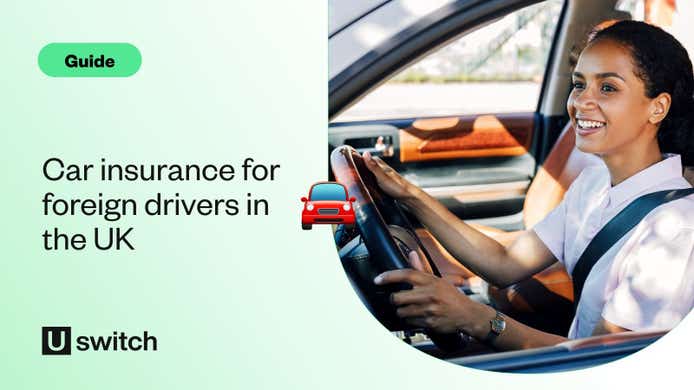Many people assume that their own comprehensive car insurance policy allows them to drive any car. Perhaps you occasionally drive your partner’s or relative's car, assuming your cover applies when you're driving other cars.
However, the likelihood is that you may not be covered to drive it at all, unless you’re specifically named on their policy. Or if you're permitted to drive other cars on your insurance, it will only be third-party cover and may only be for social, domestic and pleasure purposes. You will need to check the wording.
Get a car insurance quote
See a range of car insurance quotes in just a few minutes when you compare with Uswitch
Does fully comprehensive car insurance cover driving any car?
If you have a comprehensive insurance policy on your own car, you might have driving other cars (DOC) cover included. In the past, driving other cars cover was a fairly standard addition to comprehensive policies, but fewer insurers now offer it as it was always only intended to be used for emergency situations.
The car you want to drive must be covered by an existing insurance policy, and you must have permission to drive it.
Although driving other cars cover does allow you to drive another already insured vehicle, most policies will only cover you to drive other cars with third party only (TPO) cover, rather than the fully comprehensive cover you get on your own car.
Read our guide on the different types of insurance.
What is driving other cars (DOC) insurance?
If you have driving other cars cover, you can drive another car without being a named driver on it or having to buy temporary cover. However, the car has to be covered by an existing policy and you have to have permission to use it.
Driving other cars cover is usually only available on a comprehensive car insurance policy, so if you have third party (or third party, fire & theft) cover, you won’t have insurance to drive other cars. It's not automatically included on every comprehensive policy – so check first.
Unfortunately, driving other cars cover is not available to everyone.
Insurers will typically not insure you to drive other cars if you are under 25, as you’re seen as a higher risk to insurers. Those with criminal convictions or who have made an insurance claim on their own policy may not be able to get DOC cover either.
Driving other cars cover should not be seen as a substitute for a comprehensive car insurance policy.
If you have an accident while driving someone else’s car, you could have to pay a large repair bill.
Driving other cars insurance is only ever third party only, so it wouldn't pay for any damage you do to the car you have borrowed. You'd need to pay for that yourself.
How do I find out if I have DOC cover?
It’s best to check with your insurer to find out whether you have DOC cover, as it’s not always included automatically. Make sure you check before driving someone else’s car.
Can a named driver drive another car?
If you own a second car, note that you cannot use your ‘driving other cars’ cover from your first car to avoid taking out insurance on the second car. Driving other cars cover is an add-on intended to allow you to drive other cars in an emergency, and will not extend to other cars you own.

Can I drive someone else’s car without DOC cover?
Add your name to the policy: If you need to drive another person’s car regularly, or even occasionally, they should add you as a named driver on their insurance policy. Depending on your driving experience, it could even help to cut the cost of their cover.
Temporary car insurance: Alternatively, you could consider temporary cover if you plan to borrow their vehicle as a one-off. You can even get one-day cover to drive someone else's car.
Can someone else drive my car?
The same rules apply if someone else wants to drive your car. To be covered, they will either need to have DOC cover, be added to your own insurance policy as a named driver or take out a temporary policy.
A temporary insurance policy may be a good option if, for example, your son or daughter wants to drive your car while they are home from university, and they're not covered on your insurance.
Alternatively, you could consider ‘any driver’ car insurance, which means anyone can drive your car – there’s often no limit to how many people can drive it. However, this type of policy isn’t very common, and you may find it’s expensive.
What if I don’t have my own insurance policy?
It’s important to understand that you can only drive a car if you have insurance. If you don’t have your own insurance policy (either on your own car including DOC cover, as a named driver on the car owner’s policy, or standalone temporary cover), you are not legally covered to drive.
Remember that it’s not the car that’s insured – it’s the driver. So while the owner of the car may have an insurance policy for the vehicle, each driver needs to have their own insurance (either via driving other cars cover or a temporary policy), or be specifically named on the policyholder’s insurance policy.
All things considered, it’s best not to jump into a friend’s car and assume you can legally drive it, even with their permission.
Get a car insurance quote
See a range of car insurance quotes in just a few minutes when you compare with Uswitch
FAQs
How do I check if I am insured to drive other cars?
Check your policy documents or call your insurer to find out if you have driving other cars insurance. You may also be a named driver on someones else's policy, for example a parent or other family member. Always check before you get behind the wheel.
Is there a penalty for driving someone else's car?
If you are caught driving someone else's car without insurance you could get a fixed penalty of £300 and six points on your licence. It could be worse if your case ends up in court. You could get an unlimited fine and lose your driving licence.
When can I drive another car on my insurance?
You can only drive someone else's car on your insurance policy if it includes driving other cars insurance. This will only be third-party cover, even if your own policy is fully comprehensive.
Can I drive my partner's car?
You may be able to drive your partner's car if you have driving other cars insurance on your own policy. This will only be third-party insurance though.
If you need to drive your partner's car regularly it may make sense to ask them to add you as a named driver to their policy. This could be on a fully comprehensive basis and, if you're a more experienced driver, bring their insurance costs down.
Can I get insurance for anyone to drive my car?
Possibly. Any-driver insurance lets anyone drive your car, so long as they have your permission. The catch is that it's expensive and will exclude some drivers, for example those under the age of 21 or 25. This type of policy is better suited to businesses that may have a fleet of cars they want employees to drive.
Can I get insurance to drive someone else's car if I'm under 25?
Many insurance companies don't allow drivers under the age of 25 to have driving other cars insurance on their policy. This means that if younger drivers need to drive somebody else's car they may need to arrange temporary car insurance or ask the car owner to add them to their policy as a named driver.




